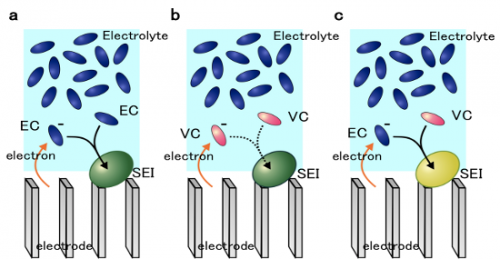Success in elucidating reduction reaction mechanisms of lithium-ion battery electrolytes using the K computer

Researchers from the National Institute for Materials Science (NIMS), in collaboration with Fujifilm Corporation, succeeded in elucidating, on the atomic level, reaction mechanisms of the reductive decomposition and binding of electrolytes toward formation of solid electrolyte interphase on the interface between electrolyte and electrode, by using the K computer, the current flagship supercomputer in Japan. The findings will play a key role in improving the performance and safety of lithium-ion batteries (LIBs).
LIBs are widely applied in devices used in everyday life, such as personal computers and smart phones. In recent years, the development of large batteries - for example, batteries used in electric vehicles, aircraft and at home for the smart grids - has been carried out extensively. However, LIBs still have many technical problems which need to be overcome in order to achieve both higher performance (including larger capacities), and better safety, represented by high reliability and long life cycle. The key to improve the performance and safety lies in the reductive decomposition of electrolytes and the subsequent formation of films consisting of decomposition products on the electrode interface (Solid Electrolyte Interface: SEI). While it is already known that the quality of SEI films can be greatly improved by using a small amount of an additive substance, the reaction process in the formation of SEI films has not yet been clarified due to the difficulty in direct observation of the reactions experimentally. Thus there has been a strong demand for the elucidation of the reduction reaction mechanisms toward the future development of materials for LIBs with higher performance and better safety.
The researchers applied a computational technique combining density functional theory molecular dynamics (DFT-MD) and blue-moon ensemble method for free energy profile of chemical reaction to LIB systems for the first time in the world. By doing so, the researchers successfully elucidated, on the atomic level, the reductive decomposition process of ethylene carbonate (EC), a typical electrolyte solvent for LIBs, and of vinylene carbonate (VC), frequently used as an additive, as well as the oligomerization processes toward the SEI film formations. The mechanisms of these reactions demonstrate why the use of an additive substance can improve the performance and safety of the SEI films. In this research, the researchers used the K computer to carry out comprehensive and high-accuracy simulations of chemical reactions, which had been difficult with ordinary supercomputers.
The findings in this research surely provide important aspects on the processes of the electrolyte decomposition and SEI film formation in LIBs, which have been long-standing problems so far. The present elucidation will contribute to further design and development of high-performance SEI films. Furthermore, this research demonstrates that high-accuracy simulations of chemical reactions on the 'K computer' enables us to do comprehensive 'computational material design' of new electrolytes and additives that can enhance the performance and safety enough for future large batteries.
This research was conducted as part of the research under a JST Strategic Basic Research Program, Precursory Research for Embryonic Science and Technology (PRESTO), in the field of "Phase Interfaces for Highly Efficient Energy Utilization" (Research Supervisor: Nobuhide Kasagi), using the K computer in RIKEN, Japan. The paper on this research was published in the Journal of the American Chemical Society as of August 1, 2013 (EST).
Journal information: Journal of the American Chemical Society
Provided by National Institute for Materials Science





















